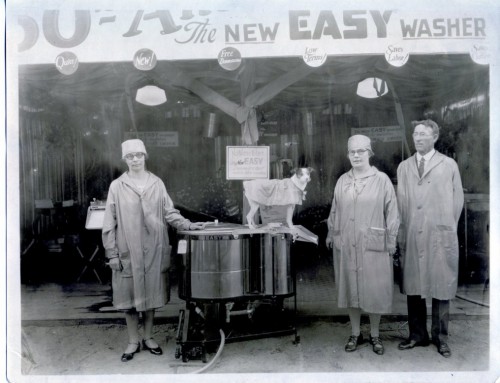by TeAnna, Exhibit Intern
Sometimes, whether it is writing a lengthy essay for your class, completing and designing a large project for work, or even reorganizing your room, your original plan does not always end up as the final product. In the midst of your work, new ideas or new information can appear that make you completely reconsider your current “game plan”. At first, these small epiphanies, as I like to call them, can seem like more work than it’s worth, but in the end, they really make the difference between a good finished product and an excellent finished product.
Very recently, I had one of these epiphanies in regards to the layout of the Clothing Through Time exhibit.Originally, the clothing exhibit was going to be organized as a giant timeline. As you slowly moved through the exhibit space, you also moved through the history of clothing, literally walking through time. After all, this exhibit is based on clothing, through time. This is an idea implemented in many museum exhibits and I believe, would have showcased the gradual change in clothing styles. However, upon sorting through the available clothing with known time periods, I came to a realization that the Willamette Heritage Center clothing collection does not have a sufficient amount of clothing articles for each decade. If I was to follow through with the timeline exhibit plan, there would be under-represented decades, over-represented decades, and even decades that did not have any clothing articles to display. The exhibit would appear to be very incomplete and jumbled, something I definitely want to avoid.
Realizing that I could not design this exhibit in this manner, a new idea/realization came to me. What if the exhibit was not focused on a changing historical time-frame, but little thematic exhibits? Derived mainly from categories found within the archival records, I came up with seven themes to display: Everyday Men, Everyday Women, Children/Infants, Undergarments, Formal Attire, Worldwide events (WWI/WWII) and Local Events. Through the strategic use of movable walls, I designed a way for each theme to have their own section or wall within the main exhibit. Another part of each exhibit wall or section will be devoted to asking/displaying thought-provokin8g questions to ponder while touring the exhibit. Questions such as: “In 50 years, what clothing styles will be displayed from your generation?” and “How do clothing styles and important historical events go hand-in-hand?”
What I am really looking forward to the most is the section for Children/Infants. Not only will this section be used to display the history of children’s clothing, but it will also be a kid-friendly place for children to interact with the exhibit. The details are still in the works, as it is unclear what condition some of the children’s clothing is in. It would be wonderful if there could almost be a “dress-up” section, but we would not want to ruin any clothing deemed too fragile.
Epiphanies such as this are not uncommon for me, as I have realized. Choosing to completely scratch all my previous work seemed like such a silly idea. An exhibit that I had previously designed for the Oregon State Hospital Museum went through a drastic planning change and it turned out better than I could image, giving me hope and encouragement that this exhibit will turn out just the same – fantastic.



